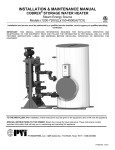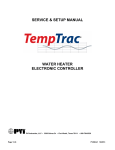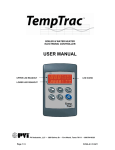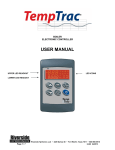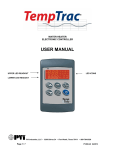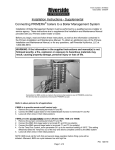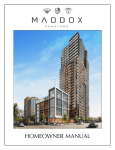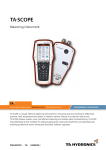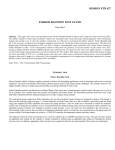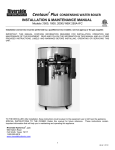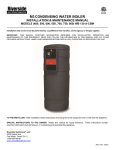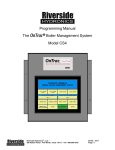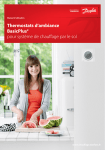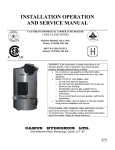Download START-UP OF VT.3 WATER BOILERS
Transcript
Form Number 34-23 08-10 START-UP OF VT.3 WATER BOILERS For Detailed Information See Installation & Maintenance Manual WARNING: If you do not follow these instructions exactly, a fire or explosion may result causing property damage, personal injury or loss of life. 1. Visually inspect boiler and components for damage and proper installation. 2. Turn off all electrical power to the appliance. 3. Turn off main manual gas valve. 4. Check all electrical connections for tightness, proper voltage, and proper grounding. 5. Check tank to make sure it is full of water. Ensure all plumbing connections to the tank are tight. 6. Verify that the unit is supplied with the type of gas specified on the rating plate. 7. Connect a test meter to the control for reading the flame response signal. 8. Connect a manometer at the manual gas shutoff valve located at the inlet of the gas train. Check inlet static gas pressure (must not exceed minimum listed on decal). Leave manometer in place throughout testing. 9. Connect another manometer to the manifold test port at the shutoff valve closest to the burner. 10. Turn on all electrical power to the appliance. Reset all safety devices (high limit, pressure switch, Low-Water-Cutoff, etc.). 11. Turn the manual gas valve to the “ON” position. The Ignition Control should go through its “Call For Heat” process and ignite the burner (see sequence of operation in manual). 12. The boiler has three temperature controls. The High Limit control is a manual reset nonadjustable type. The Lower Limit is an auto reset type and can be dial adjusted to operate just above the set point of the digital Operating Temperature Control. Set the adjustable digital Temperature Control on the front control panel to deliver the desired water temperature. 13. Check inlet flow gas pressure (should meet or exceed minimum listed on decal). 14. Measure the manifold gas pressure at the tapping located on the gas cock nearest the burner to confirm the factory recommended set point (check while firing at both low fire and high fire, if applicable). 15. Drill hole in vent pipe 12” to 24” from appliance flue outlet (for combustion analysis equipment). 16. Burner Combustion Adjustment: Burner combustion should only be adjusted using a combustion analyzer. Do not attempt to adjust burner by sound or sight. With the burner firing, insert the combustion analyzer probe into the vent pipe. In order to check combustion at throughout the modulation range it is necessary to manually adjust the firing rate using the TempTrac control. (Refer to TempTrac User Manual 34-80 for control details). 1 a. With the burner firing and adjusted to low fire adjust the regulator screw clockwise to increase gas flow or counter clockwise to decrease flow. The desired CO2 in the combustion products should be between 7.5 and 8.5%. Do not attempt to adjust combustion based on manifold pressure alone. Manifold pressure should only be used as a reference point. b. Once the desired combustion is achieved at low fire, raise the burner firing rate in increments of 20% or less. At each firing rate adjust the valve orifice clockwise to reduce the flow of gas and counter-clockwise to increase the flow of gas in order to maintain the desired combustion as noted in step (a). c. When high fire combustion has been reached and combustion is within the proper range, return to low fire to confirm settings again. Repeat step (a) for low combustion and (b) if further adjustment of range is necessary. CAUTION: If at any point of the modulation range, carbon monoxide is in excess of 300ppm, contact Riverside Hydronics customer service for assistance. 17. Check the flue gases with an electronic combustion analyzer to make final adjustments to the gas pressure regulator. When water in tank is above 120°F, insert the analyzer sensor into the hole in the vent and record: a. O2 should be 5 ½% to 7% (target 6 ½%) b. CO2 should be 7 ½% to 8 1/2 % (target 8%) c. CO should not exceed 200 PPM d. Net stack temperature should be 275°F - 375°F 18. Measure the vent draft using a manometer or draft gauge and record the draft (should be negative .02” to negative .06” W.C). Vent draft outside this range may indicate a inadequately sized misadjusted vent. To prevent products of combustion from escaping, cover the test hole in the vent with aluminum adhesive tape. 19. Check the operating control to be sure it functions properly by lowering and raising the operating temperature setting (see section “Thermostat Setting”) causing the burner to cycle on and off. 20. Complete the attached startup report pages 3 & 4. Note: A complete and proper start-up of this equipment is required to ensure its safe and reliable operation. The attached startup form must be filled out completely, and immediately provided to your Riverside Hydronics® representative. Report all discrepancies to Riverside Hydronics® Customer Service Department at 1-800-990-5918. 2 Form Number 34-23 08-10 START-UP REPORT VT.3 Water Boilers Warning: Startup must be performed by a qualified service installer, service agency or the gas supplier. Serial Number: Model Number: Job Name: Address: GENERAL INFORMATION Restart? Yes No Installation is: Primary operating voltage supply: Thermostat Setting: New Replacement/Renovation VAC Voltage from neutral to earth ground: °F Thermostat Setting: °F Is the Pressure Relief Valve plumbed to a suitable drain? Yes Energy management System (EMS) Interface? Remote On-Off Yes No Staged- Firing (should be zero) °F No Yes No Mfg. /Model: Outdoor Reset EMS connected to which boiler terminals: Other: MODBUS Control? EMS Field wiring - Wire Gauge: Outdoor Hi-Limit Setting Is the boiler condensate drain connection plumbed to a suitable drain? EMS Function(s): Indoor Distance from EMS panel: Yes No Ft. BOILER INSTALLATIONS (Closed Loop Heating System) Boiler water supply and return piping size Supply water temperature: °F Return water temperature: What is the GPM of the building loop circulator pump? What is the location of the circulator pump? °F VFD? Yes Downstream from boiler Is there a balancing valve (circuit setter) in the boiler loop? No Upstream from boiler Yes No VENTING and COMBUSTION AIR Vent Material: Vent Type: Through-the-roof Through Sidewall Does vent have condensate drain? Does vent have elbows? Yes Yes No; No Direct-ducted combustion air? Yes No No Duct Material: Are louvers interlocked with boiler? Draft Regulator? Power Vent Yes Is combustion air supplied by louvers inches; Vent Length: Yes feet No Qty / Type: Does vent contain any of these devices? Is vent device interlocked with boiler? Vent Diameter: Draft Inducer Vent device connected to which boiler terminals: Duct diameter Does duct have elbows? or openings Yes Other No Qty: inches. Yes No; Duct length feet. Qty / Type Size: Louvers connected to which boiler terminals: 3 Form Number 34-23 08-10 Model Number: Serial Number: GAS SUPPLY Type of Gas: Natural LP Gas Supply Pipe Size: Max available gas pressure: Lb/Oz Gas Regulator Model: Range: Inlet Static Gas Pressure: " W.C. (See rating decal for maximum inlet gas pressure) Inlet Flow Gas Pressure: " W.C. (See rating decal for minimum inlet gas pressure) Combination Gas Pressure Switch Setting: High " W.C. Low " W.C. COMBUSTION ANALYSIS Low fire Combustion Data ( Full modulation) 50% 75% High fire Flame Safeguard model: Flame Signal Oxygen O2 (5 ½ - 7%) Manifold Gas Pressure Carbon Monoxide CO (should not exceed 200 PPM) Carbon Dioxide CO2 (7 ½ - 9%) Nitrogen Oxide NOx (ppm) Vent Pressure (-.02 to -.06” W.C.) Gross Stack Temperature °F Ambient Air Temperature °F Net Stack Temperature °F (gross stack minus ambient air) Combustion Efficiency % Important: You must submit the original copy of the completed form to your Riverside Hydronics representative before the warranty will become effective on this product. Comments: Phone: Service Company Name: Service Co. Address: Date: Start-up Performed By: Customer: Phone No.: Date: 4 Form Number 34-23 08-10






